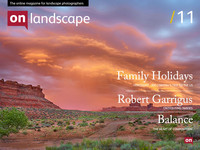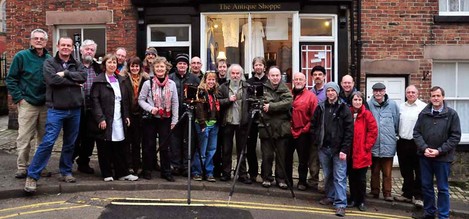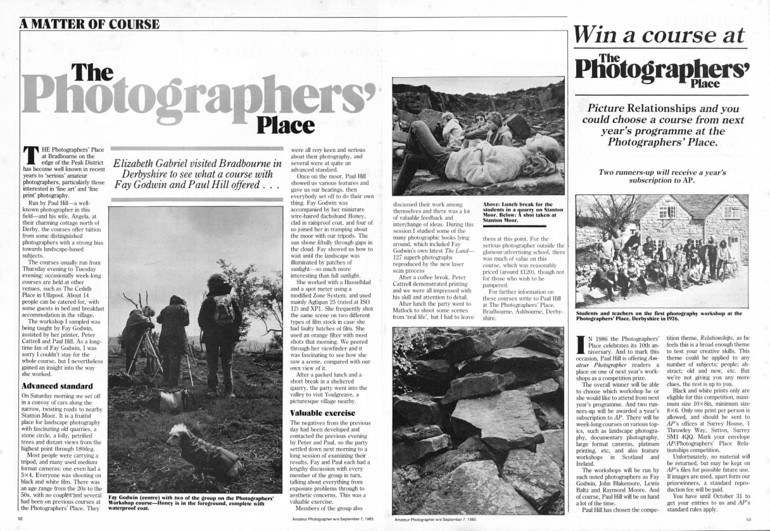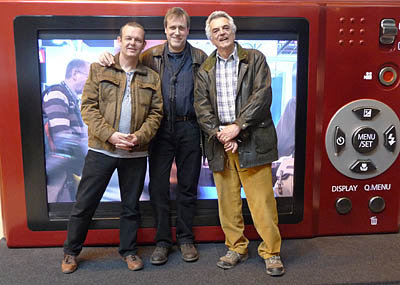Tim Parkin muses on his photographic development

Tim Parkin
Tim Parkin is a British landscape photographer, writer, and editor best known as the co-founder of On Landscape magazine, where he explores the art and practice of photographing the natural world. His work is thoughtful and carefully crafted, often focusing on subtle details and quiet moments in the landscape rather than dramatic vistas. Alongside his photography and writing, he co-founded the Natural Landscape Photography Awards, serves as a judge for other international competitions. Through all these projects, Parkin has become a respected and influential voice in contemporary landscape photography.
A couple of weeks ago I went on a workshop, a workshop that continues a series that started in the early 1980s and that have along the way have had photographers such as Fay Godwin, Lewis Baltz, John Blakemore, Aaron Siskind, Paul Caponigro, Martin Parr, Thomas Joshua Coooper and Cole Weston as leaders. Despite a hiatus in the late 90’s and early 00’s, the series has restarted, led by one of the founders, Paul Hill, and two of his colleagues who now teach his photography course at Trent university - Nick Lockett and Martin Shakeshaft.
My interest in the course was piqued by a special guest, John Blakemore, who I had met at an exhibition at Joe Cornish’s gallery and whose book, “Black and White Photography Workshop” had inspired me beyond what a ‘technical’ manual should. All in all, it seemed like an intriguing weekend, despite it not being overtly landscape oriented (and perhaps because of that).
This short article is not intended as a thorough review of the weekend, nor is it intended as a diary of my own weekend. It is more about my own thoughts about photography and how a workshop allowed me the space to think more about what my photography was about and perhaps where it was going.
Firstly a bit of background. My photography has been developing over the last few years in a way that has mostly been driven by improving technique in composition and craft. Along the way I have occasionally questioned my choice in subject matter and how I want to portray it, but I haven’t really spent a lot of time looking into what I am trying to portray with my photography. I sometimes feel that I am in the habit of making pretty pictures, albeit more complex and satisfying pretty pictures than I took at the start of my journey. I’ve had in the back of my head for a while that there must be some way of using photography as a means of exploring the world beyond representation, a way of using photography to develop and communicate meaning.
Out of the photographers I have seen that seem to manage something in this direction (Alfred Steiglitz, Edward Weston, Minor White, Harry Callahan, Jem Southam, etc) they all have developed ideas and themes over time and have mined their output for new germs of creativity. The old Photographer’s Place had a reputation for approaching photography in terms of narrative and theme instead of craft and it was this aspect that I thought I could gain from.
The workshops are based in Wirksworth in Derbyshire and I arrived just as Paul Hill, Martin Shakeshaft and Nick Lockett were talking about their own work. If I can summarise them, Paul Hill was the founder and one of the original Photographer’s Place tutors (along with Raymond Moore) and was chairman of the contemporary group of the Royal Photographic Society (along with getting an MBE for services to photography). For more details take a look here.
Martin Shakeshaft is probably known to quite a few people for his photographs of the miners strikes in the 1980’s and has continued this theme recently and finally Nick Lockett is an editorial photographer who worked for many years for ITN, has been working on personal landscape projects regarding tracks in the landscape and now lectures at the DeMontfort university.
Following this was an ‘introduce yourself’ session for each of the approximately 12 people in the workshop. The attendants work ranged from documentary projects on domestic abuse, travel photography, student projects about the land or about closure of factories, etc. and the attendants themselves ranged from young to old, male and female and from relative beginners to quite proficient, advanced photographers.
This session ended the official work of the evening but we had a few conversions about what we were looking for and looked through a good range of books available (including ‘Inscape’, a fantastic book by John Blakemore that I hadn’t seen before).
After a reasonable night’s sleep in the ‘dorms’ at the residence (a converted church building), the morning started with a short talk by Paul Hill showing his recent work and then talking about how working in projects and series works and how the aim of the day was to try to being thinking in this fashion and, if possible, to create a few pictures to discuss the next day.
Now everything Paul had said so far implied that the way to start with this type of project is to begin shooting intuitively and then to examine your own pictures to try to work out what parts of this work stand out and to then work to develop those ideas and carry on shooting and interpreting iteratively until, well, until you get bored or can’t shot anymore or something else comes up, etc., etc. So what chance do I stand in developing something in a few hours? Well in my case I thought I’d work with what I know which was that there was a quarry I had seen locally and combining this with a desire to try to work in black and white as a precursor to putting some black and white through my 8x10. I couldn’t work on a narrative in such a short period of time but I had in my head that I want to explore how the quarry was used since it closed down.
Working whilst thinking about the project was intriguing and a rainy day made for challenging conditions but this helped in being able to see in black and white. I had an enjoyable session walking around with Nick Lockett, another large format landscape photographer, and although I didn’t have enough time to really think about what I was trying to achieve, I did get a few photographs and then it was time to head back.

Photos taken on course - second image is a photograph of the back of the large format camera using a Lumix LX5
We came back for a short break where I had a very interesting conversation with one of Paul’s graduates, George Miles (www.georgemiles.co.uk) who studies under Stephen Shore. He mentioned that Stephen Shore is a big Eliot Porter fan which surprised me but probably shouldn’t have having seen Shore’s rain forest work. The conversation was centred on the role of beauty in fine art and that there is definitely a bias away from overt beauty, almost a trivialisation of it.
The main focal point of the day was John Blakemore’s presentation on his work and the process of photography. John comes across as a sort of ‘pan’ like figure, still full of wonder with the world and very passionate about his work but with a chaotic streak running through things, a momentary irreverance that I found most appealing.
Instead of all sitting in rows with John presenting to us from on high, we all sat around a table and John talked about his work and passed around example prints. And these prints are something beyond anything I’ve ever seen. I went to the Ansel Adams exhibition recently, expecting to see some good printing displayed and, despite them being very good, I wasn’t blown away. I then went to see some of Fay Godwin’s exhibition prints and these were very nice too - I preferred them to Ansel’s in some ways but I could see that they didn’t exhibit quite the control. John Blakemore’s black and white prints take things to a different level completely - I didn’t want to let some of them go as they were passed around.
I’ve since found it difficult to describe why they affected me so much. Obviously the subject matter was beautiful also but I think it’s because he has such an amazing control of high and low key areas and a few prints that were handed out worked in the very top or bottom couple of zones - i.e. zones 1-3 or 8-10 in some cases. In other cases, the combination of print and paper quality added up into something almost visceral - a lot of the ones I was impressed with were printed on Agfa Record Rapid, a very popular paper in it’s day and one that has a surface half way between smooth matt and glass - like a good quality book print looks but with much more depth and tactility.
Anyway - although the prints blew me away, it was what John said that really affected me. Now this is going to be difficult to describe and may sound trite in some ways but I’ll give it a go anyway.
John’s way of working is to use each photograph as a step towards a different way of thinking. Each photograph is a base camp in a journey of discovery or as John eloquently puts it "An individual photograph becomes not an end in itself but a link in a chain of expanding visual possibilities".
We have featured John in our latest Master Photographer series and have a review of his book “Black and White Photography Workshop”.
The course continued that evening but seen in a new light after the discussion with John and George. We spent some time looking through each others portfolios and discussing how we came to work the way we did. This is one of the key parts of photography workshops that isn’t mentioned. Whoever the workshop leaders are, you *will* get as much out of the conversations you have with other participants if you make the effort to discuss your work with them. Everybody has expertise in different areas and even though you may be a more advanced photographer, they will still have valid points to offer (even if it is only their considered opinion of your work as a third party). For instance, a woman on our workshop was working on a project about domestic violence and her connection with her own work was extraordinary. She had interpreted her own involvement in the project in a way in non-obvious ways which made the work even stronger for it. Many people may say that landscape work doesn’t offer the opportunity to make strong connections in the same way that work with people in does but I would disagree. It makes it harder and the connections may not be as instantly obvious but they are still there if you work hard on them and from this work that I saw, it made me want to try even harder to create a relevant body of work.
After a short sleep in the bunk bedded group accommodation (satisfactory if you are happy with Youth Hostel style accommodation) we reconvened to review our work from the previous day and I was recruited to help make a presentation on large format photography (never pass up a chance to evangelise!) after which many of the participants had their work reviewed by Paul Hill (an opportunity that I am going to take up once I feel I’ve built up a small body of work influenced by my time at the workshop).
Overall - the location is highly recommended (although I would avoid if you have a need for regimented scheduling and organisation - the planning is best termed as loose but this has it’s benefits). Go with an open mind and make the most of the opportunity to talk to landscape photographers that work in a more documentary or ‘fine art’ (oh I hate that phrase) genre.
Oh - and if you’re interested in large format photography and workshops, Tim Parkin and Dav Thomas have a place left on their March 25th Introduction to Large Format workshop - I wouldn't normally advertise my own services here but any profits from the weekend will get ploughed back into the magazine so if you need to convince the holder of the purse strings, just tell them that you have to go to support variety in landscape photography journalism! Maybe...
Read further: The Original Landscape Workshop - Remembering Fay Godwin & Paul Hill




